From the My Car Quest wayback machine all the way back to July 2016 I found this very interesting story that many of you may not have read before. I hope you like it.
Mike Gulett, Editor
by Wallace Wyss –
Just for the fun of it, let’s compare two icons of front-engined sports cars from the Sixties.
One was borne out of a long tradition of building competitive sports cars, cars that took the 24 Hours of LeMans, cars that represented the very best of Italian engineering and design.
The other was, let’s face it, merely a rebody of a frame designed in 1953, itself copied off a couple of “specials” created by a Brit for private customers who couldn’t afford Ferraris but wanted cars that were Ferrari-like (two of the Trojiero Specials copying the body shape of the Ferrari 166 “Barchetta”).
To summarize Cobra history in a few lines: the A.C. Ace of 1953 came about when A.C. Cars Ltd. bought the design from the engineer John Trojiero. A.C. then put it into production as the “Ace” with their ancient engine but then switched to a Bristol six, where it was successful. Then when Bristol announced the end of that engine, A.C. switched to a Ford six.
Soon after, Carroll Shelby arrived in his jeans and Stetson (all right, I know “all hat and no cattle”) with a Ford V8. That marriage begat the Cobra, as a roadster. But though it could blow most Ferrari production cars into the weeds in the curves, it had an aero barrier—around 160-mph. Brick-shaped, it could not catch the more slippery Ferrari GTO coupe on a long straightaway.
THE ITALIAN PUREBRED
Let’s face it, the Cobra was but a crudely assembled hodge-podge of parts—English frame, American V8—none of it originally designed to be in a world class sports car. The prototypes were put together by hot rodders like Phil Remington and Dean Moon—guys who had raced ’32 Fords on the dry lakes.
The Ferrari was a “purebred.” Believe me, I am involved in horse racing, and I know what pedigree means. But just to make sure you out there know what pedigree means indulge me in quoting the Thoroughbred Horse Association’s definition: “The correct way to describe a horse’s sire (father) and dam (mother) is to say “the horse’s name” is “by the sire’s name” and “out of the dam’s name”, then you say the dam’s sire “by the dam sire’s name”.
For example:
“Secretariat” is by “Bold Ruler” out of “Somethingroyal” by “Princequillo”. So Secretariat’s father is Bold Ruler, his mother is Somethingroyal and his mother’s father is Princequillo.
The “dam sire” is also spoken of as a “broodmare sire” and can be an important consideration when buying or breeding a horse. See the ranking of “broodmare sires.”
The Ferrari GTO was the descendent of a long line of successful race cars. It was “out of” the SWB 250GT and not only out of it but the hot-rodded version of that created by Giotto Bizzarrini, called the SEFAC Ferrari.
It was called the GTO for Gran Turismo Omologato which meant it was built to fit into the grand touring class for a homologated car, in other words the FIA had already approved the Ferrari 250GT and Ferrari snuck this version past them by saying it was merely a body variation on an already approved car, the SWB 250GT.
BODY SHAPE BY BONDO
Giotto had his own little development group on the car, separated from the other projects. Each night he would take the “ant-eater” (the nickname for the ugly slope-nosed prototype) with a new nose configuration, the Italian version of Bondo moved around as it were, and make a run on the autostrada to see if the car was any faster than the shape run the night before.
He finally “froze” the project when he reached around 170 mph, then thought the speed necessary to win your class at LeMans though they knew it would not be capable of winning the race overall.
THE ENGINE
In reality, the V12 engine had been moved back, and lowered in the chassis compared to the SWB 250GT. The engine had been converted to dry sump so this could be done.
The two cam V12 had six dual throat Weber carburetors but he eschewed the chance to put a hood scoop, either forward facing or rearward facing. The advantage of this engine over the Ford V8 was first that it had twelve cylinders, not just eight.
If you’re going to say “what’s the difference” as a former owner of a V12 Ferrari that often ran not on all twelve, I can tell you the more the merrier, you can be a few pistons down and still be motoring along. With a V8 you can lose less cylinders and continue though in fact a Daytona coupe did finish a major race on seven cylinders.
Both had an equal number of jets per carburetor, the GTO has two jets per carb times six for the twelve cylinders and the Ford has two jets per Weber carb for the eight cylinders. You could wind the Ferrari GTO engine near 8,000 RPM where the Ford 289 (4.7 liter) was good for about 6,500 RMP tops and all time spent over 6,000 RPM was shortening its durability markedly.
The 3-liter twin overhead cam V12 in the GTO was rated at 300 PS / 296 bhp / 221 kW @ 7500 rpm. Torque was 294 Nm / 217 ft.lb / 30 kgm @ 5500 rpm.
The Cobra Daytona coupe’s 4.7 liter pushrod V8 was, on paper, more powerful with a 287.1 kw / 385 bhp @ 6750 rpm rating. Torque was torque 460.98 nm / 340.0 ft lbs @ 4000 rpm.
But the Cobra Daytona only had a four speed manual, the GTO a 5-speed. Top end — they were probably pretty evenly matched. The GTO might have been listed as capable of 160 MPH but I think 170 MPH was reachable.
AERO
Now the GTO was designed by a graduate engineer who was also a college professor. So Bizzarrini used all the popular theories on aero, such as having a chopped-off “Kamm” effect tail named after Dr. Wunibald Kamm, the Germany aerodynamicist who said a tapered tail was best but, if that was impractical, an abruptly chopped off tail would also keep the tail down.
After the GTO was introduced with no rear spoiler one was hastily attached after the first tests on a racetrack.
The Cobra Daytona coupe was initially given short shrift, treated as a sort of a “back door” project at Shelby-American. Youthful Peter Brock, who had attended the Art Center College of Design, and who had also worked as an intern at GM Styling at the age of 19, after endless lobbying, was allowed by Carroll Shelby to build a full size car from his drawings of an aerodynamic coupe. A chassis was set aside and other workers assigned to help him. He had the advantage of already seeing the GTO up close and personal, so in a sense this was “his GTO.”
Shelby might have also supported it because there was an undercurrent of resentment at Shelby-American toward the contingent of crew cut, white shirt and bow-tie wearing Ford engineers who had arrived with the GT40. Their aloofness conveyed that they were building contemporary cars in the GT40. And they had slide rules! (ask your grandfather what those were…)
Shelby might have thought that having a by-guess-and-by-gosh aero coupe front engine car be successful would put these engineers back in their place. Show them what true grit was.
Brock’s design had the same long hood, the same tapered tail as the GTO, but Brock’s went a little further in the Kamm tail department by having an inset cam tail, which probably induced more turbulence, hence kept the rear end down more than if it had been flat-faced in the rear. The Alfa GTZ also had an inset Kamm effect tail.
Brock also added a rear tail spoiler to the car after some preliminary tests. Though Ford had a wind tunnel big enough for a full size car, apparently the Daytona was not tested in the tunnel in its first year of competition. But in the second year, 1965, it was sent to Dearborn and a few recommendations made and subtle changes made.
Another influence on the Brock Daytona coupe was the shape of the Aston Martin 212, 214 and 215 coupes. Those were aerodynamic bodies on Aston Martins. The 212 appeared in ’62 , the 214 and 215 the following year. They weren’t that successful in racing but they predated the Cobra Daytona coupe and I have seen a picture of Pete Brock in a race closely following an Aston Martin aerodynamic coupe so he can’t say he was unaware of Astons (you tend to remember the cars you race against).
Brock did not have a degree in engineering, but neither did Shelby, so one has to give credit to Shelby for being willing to take a chance on another self-taught guy’s theories. It could be Shelby saw a little bit of himself in Brock, a little bit of the kid-from-nowhere who wants to build a world-beater. He had done it himself only three years earlier.
Ironically Shelby’s own mechanical crew in the shop were skeptical about Brock’s car while it was being built, calling it “the turd” and predicting it wouldn’t do well at the racetrack. But when Brock took the Daytona coupe to Riverside and it cracked 170 mph on the straight, some of the crew cheered when they got the phone call reporting the results.
Success has a way of rapidly changing opinions.
The purpose of the Daytona coupe was really only as a place holder—Ford was developing the Ford GT40, a modern mid-engined car and had raced it in ’64 but if fell flat on its face. So Ford grudgingly supported the Daytona so they could have something that was winning while they worked out the bugs on the Ford GT40 (mostly by bringing it to Shelby and having him correct all the flaws).
BUILT IN ITALY
The first Daytona coupe was built in Los Angeles, by Cal Metal Shaping.
But the subsequent five? Over in Italy by a small carrozzeria. You have to wonder if Enzo sent spies over there to sabotage them.
THE BIG BLOCK
And yes, it’s true, there was a big block 427 (7-liter) Daytona being built, one that would have had an advantage in power of course but also reliability, the FE series side oiler a winner in NASCAR. But half way through its build, a small block Daytona was smashed in transport (summarized as “tall transporter, short bridge”) so orders went to Italy to convert it back to a small block.
STREET WORTHINESS
Ah, I know you Cobra Daytona fans will cry “foul” at the inclusion of this category, protesting “but it’s a race car,” but I personally have been driven to the market in a real genuine certified rootin’ tootin’ 250GTO (loaned to a Motor Trend assistant art director for a week by Steve Earle) and can assure you that it drove like a regular car in traffic, no over-heating, no drama but lots of wonderful noise. After all Ferrari was trying to convince the FIA it was but a variation on an existing street car so it was civilized, say as much as a panther on a choke-collar. Looks beautiful but has a nasty bite if you cross it.
I have never been in a Cobra Daytona that’s being street-driven but I imagine it’s a lot cruder, and a lot hotter inside than the GTO. After all, none of the civilizing things that make a car streetable were brought over from the donor roadster that provided the chassis. In fact how Shelby got the car past the FIA is still mysterious, but they may have figured, hey, more people will come to the races and turned a blind eye.
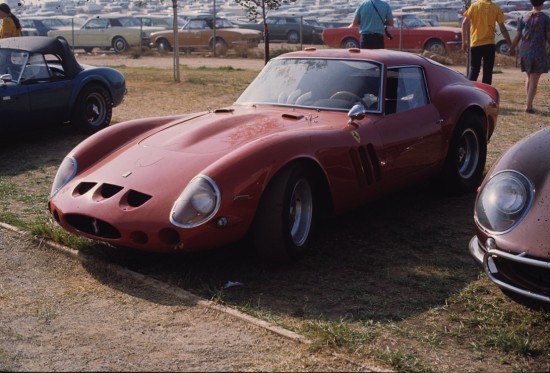
Ferrari 250 GTO in the parking lot of the Riverside Race Track, 1970, owned by Stephen Mitchell – photo by Larry Crane
COMPARATIVE VALUE
So flash forward a half century or more. These two fastbacks are now the two prima donna sports cars of the Sixties. Rarely does an example of either come to auction. Remarkably all of the Daytona coupes, all six of them, have survived. Also remarkably, all of the Ferrari GTOs have survived. The actual number of GTOs is a little controversial, most saying 36 but if you count three prototypes there are 39.
Relative values of the two, though, are far different. I remember a Daytona coupe selling at the Mecum auction in Monterey in 2009 for $7,685,000.
A Ferrari GTO sold for $38,115,000 at the Bonhams auction in Monterey in 2014 though rumors persist one privately changed hands in recent years at $70 million.
Why is the more plentiful one worth more than the more rare one?
CLASS IS CLASS
Well, that brings us back to pedigree. I know people with fine quarterhorses. And beautiful as some of them may be, they ain’t thoroughbreds.
A Ferrari race car brings with it a mental collage of images of LeMans, shooting around the back roads on the French Riviera, playboys, movie stars, the whole kit and caboodle. And you have to figure that, when that car was conceived, Enzo Ferrari was still alive, indulging in skullduggery behind the scenes to get it approved by hook or by crook. Not to mention Ing. Bizzarrini, the man who later created cars under his own name, was the mastermind. Here you had The Mad Professor creating his most brilliant creation.
The Cobra Daytona coupe, on the other hand, has no street image (unless you want to count Phil Spector trolling Sunset Blvd. in his, though he subsequently besmirched the image of Daytona owners by being put in jail for murder).
The Cobra Daytona coupe didn’t “make the scene” like the GTO did but was seen mostly on racetracks where, after Shelby stopped racing them, they flat disappeared and didn’t come out to play until almost a decade later when Steve Earle and a couple GTO-owning buddies brought theirs to Laguna Seca, to the first of what became the vaunted Monterey Historic Races.

Bev Spencer in GTO 4219 at the Hillsborough Concours d’Elegance in May 1963 – photo from the Spencer Family Archives
Both models have figured in some lurid headlines. In my Incredible Barn Finds series, I either have already chronicled some of the back stories, or will. For instance, how one Cobra Daytona coupe was involved in a suicide, and then there’s the story of a drug dealer who owned a 250GTO but whose enjoyment of it was cut short after he was murdered by his gang, miffed that he had fled with the drug gang’s loot.
My druthers? Between the two, faced with a choice of one or the other, I’d take the GTO. Maybe it’s the yellow shield with the prancing horse on its flanks, maybe it’s the glorious WHOOP-WHOOP sound of that V12 bouncing off the canyon walls in Malibu (I forgot to say I tagged along with the Ferrari’s Owners Club when they would race their cars, including the GTO, though Malibu on a Sunday morning).
I know…. I know…you’re talking to a guy who wrote three books on Shelby….
Let us know what you think in the Comments.
THE AUTHOR: On August 19th Wallace Wyss will be selling his art at Concorso Italiano.
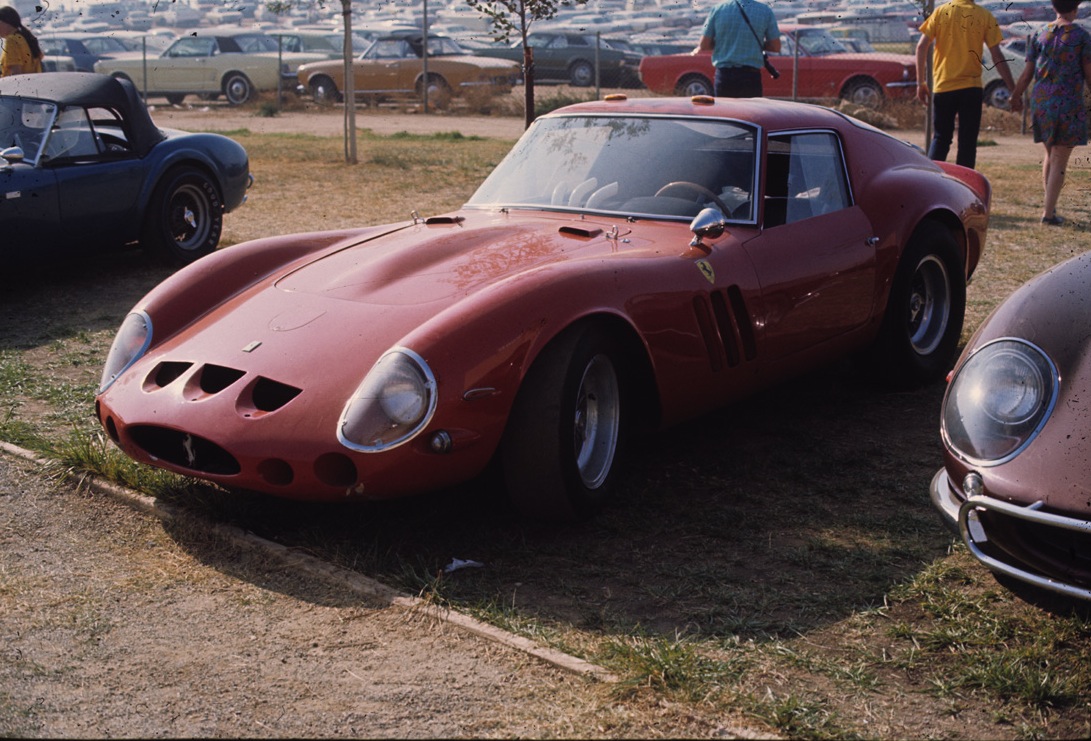
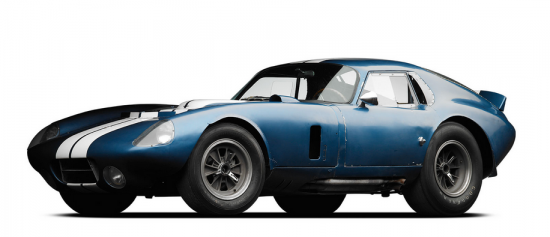
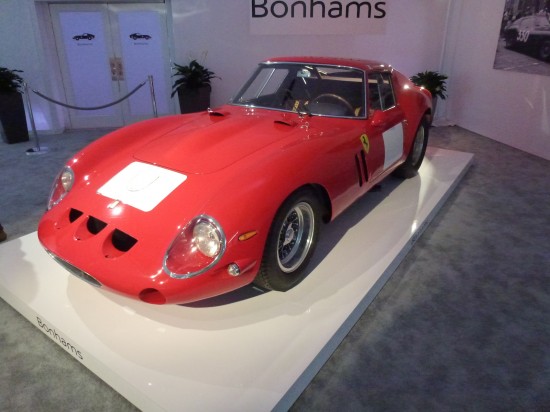
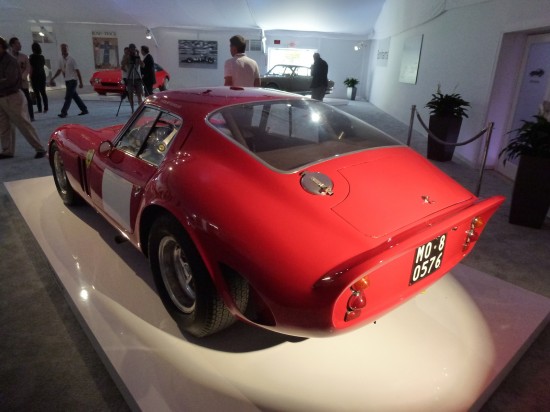
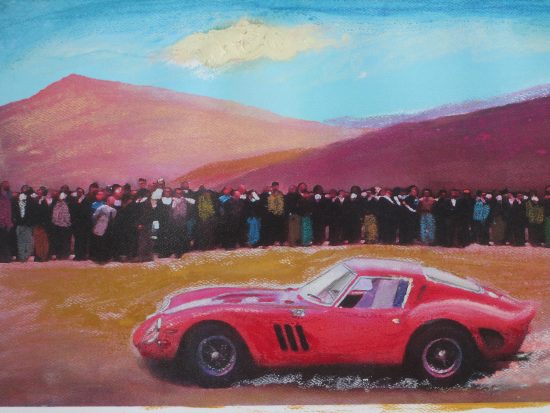
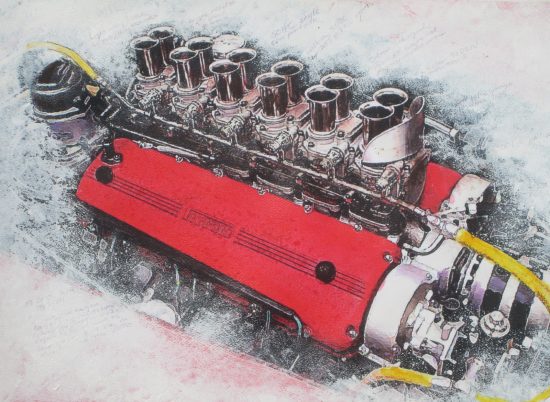
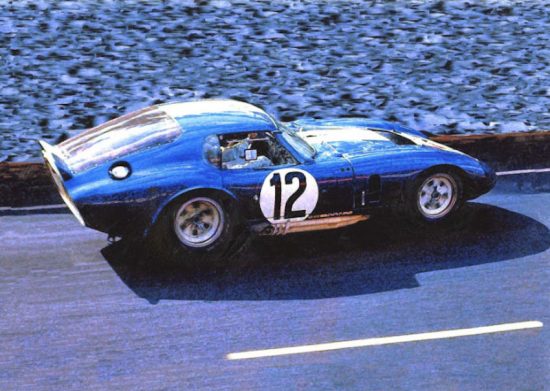

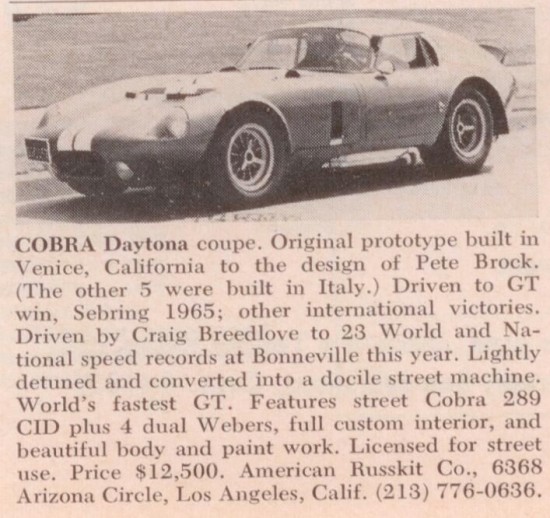
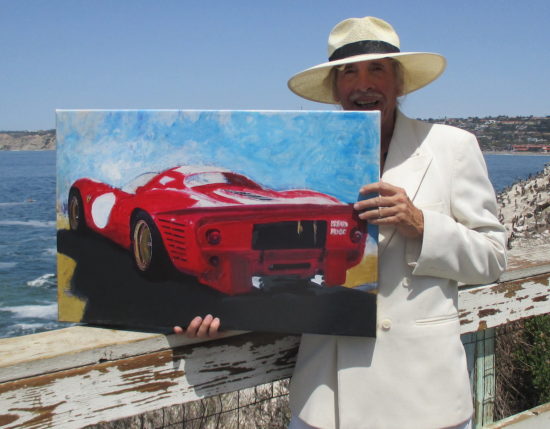
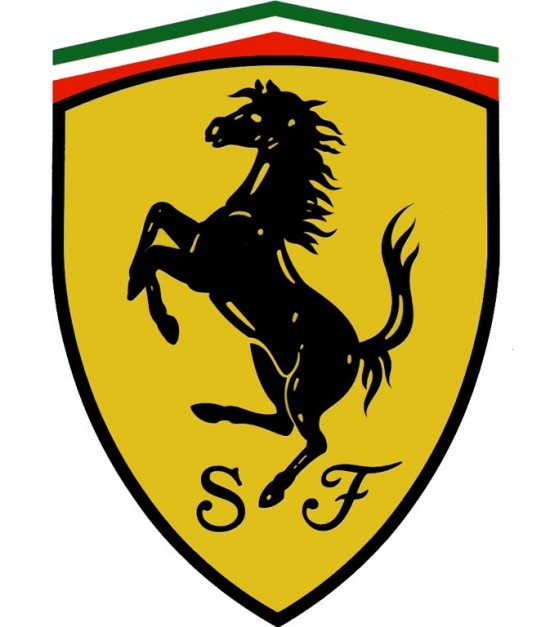
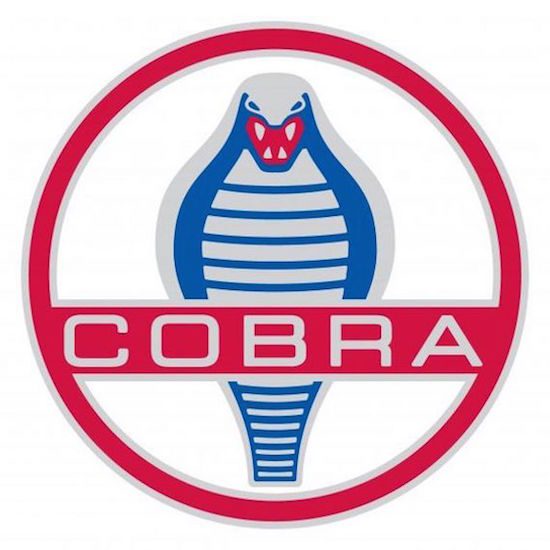
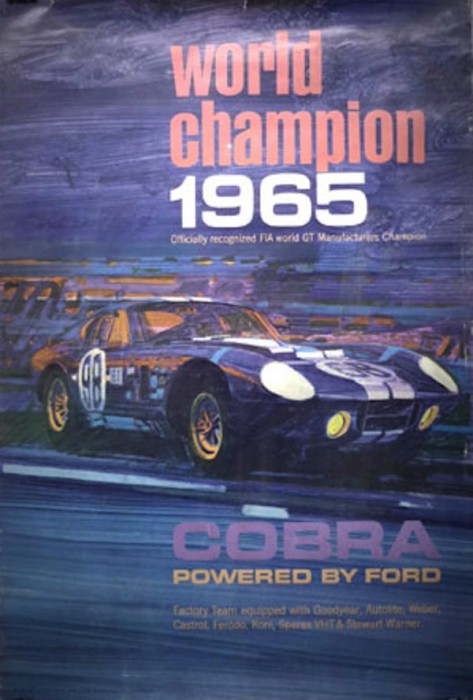



Nice frame! Not only made in Italy but in Modena!!
To my eye, both the GTO and the Daytona coupe are stunningly beautiful cars. What is neat about the Daytona coupe is that one can buy a recreation of one of these for a fraction of the cost of an original if one were available (not inexpensive, but far less than what an original would bring). I believe Kirkham has built Daytona replicas out of aluminum and there are some nice fiberglass replicas too (Superformance and the Brock Daytona coupes are a couple). Not many GTO recreations out there. Then there is the AC A98 LeMans coupe! AC’s version of a Cobra derived coupe that was wrecked at LeMans back in the day and subsequently resurrected and alive in England. A beautiful Cobra derived coupe that is not well known.
Well, no, Maranello, actually. But a relatively civilized car … although as Wallace says, a panther on a leash.
I never drove a Daytona, but ran a couple of Cobras. Their torque would keep your attention riveted in corners, and they were a bit hard to stop. My GTO was more docile; but with still enough oomph, above 4500 rpm, to put you sideways if you got sloppy. And, at 2100 pounds with the 5-speed box and big brakes, a dream to set up for turns.
But both these cars, Daytona Coupe and GTO, were SO important in the long-term quest for speed and agility. They basically demonstrated the limits of front-engined racing, and the mid-engined inevitability for all (even Enzo!) to see. Lower-lighter-lower-sleeker-lower was to be the name of the game.
Both cars were hard to tame—rough as a cob, loud as bedlam on a full moon, hot as hell on Judgement Day. The Daytona is rare as chicken lips and the Ferrari slightly less so. Why they don’t have the same collector cachet is an elusive question. But if I still had my old GTO, I’d put an electric fan in it and take my honey to dinner. I don’t know if I’d do that with one of Brock’s buggies!
Are you the author of “Full Circle”? Nice poetry!!!
Hi Luca – My wife Petra is the author. I just take writing assignments from her, on my areas of specialty like bragging and getting upside down. Petra is also a published poet and she’ll appreciate your kind compliment very much.
And thanks for reading Full Circle. If you have any questions at all about the contents, feel free to contact us:
Larry – lperkinssma51@gmail.com 303-868-6670
Petra – petraperkins1@gmail.com 303-929-6055
Grazie mille!
Both priced way out of the range of most civilians.
Glenn in Brooklyn, NY.
Yes Glenn they are but we can still dream no?
Dear Mike,
Sure, why not? While we’re there, have me driving a Shelby Daytona Coupe with my passenger/lover, Ms. Scarlett Johannson, going up the PCH to Monterey for the weekend! Sign me up – I’m all in!!!
Glenn in Brooklyn, NY.